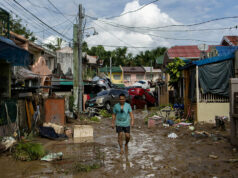MB member cites ebbing price pressures
INFLATION PRESSURES “have subsided” after overall price increases hit a nine-year peak the last two months, according to a member of the central bank’s policy-making Monetary Board, even as he cited the need to lift import restrictions for rice soonest as a key step to keep such pressures at bay.
“The pressure has subsided for now,” Monetary Board Member V. Bruce J. Tolentino told reporters yesterday.
“Harvests are in and even for meat and vegetables and fish, the pressure is down. We’re being helped by the oil, so in total, the big things — food prices and rice prices — the pressure is off right now.”
Inflation steadied at 6.7% in October from the previous month’s level, which was a nine-year peak, driven largely by food and oil costs.
However, central bank officials noted a sharp decline in month-on-month inflation, which they took as a sign that price pressures are ebbing.
Prices rose by 5.1% overall in January-October, well beyond the original 2-4% target set by the Bangko Sentral ng Pilipinas (BSP) for 2018. That prompted the central bank to carry out five consecutive rate hikes totaling 175 basis points (bp) to rein in inflation expectations, in hopes of bringing full-year inflation down to a 3.5% average in 2019.
Mr. Tolentino, who once served as deputy director general of the International Rice Research Institute, flagged that rice supply problems may recur in the coming years, which could spur inflation to shoot beyond target anew.
“On food, unless we do tariffication, unless we start investing in R&D (research and development) and irrigation, it will happen again,” he said.
Lifting of rice import restrictions coupled with investment in climate-resilient crops will help sustain the long-term reduction of rice prices, experts said in a forum on rice and inflation at the central bank headquarters in Manila on Wednesday.
Authorities hope to bring inflation below four percent in 2019, saying that lifting import quotas on rice and replacing them with regular tariffs would reduce the headline rate by 0.7 of a percentage point in 2019. The increased supply of the crop is expected to bring down rice retail prices by as much as P7 per kilogram (kg).
The measure, which has been approved by both chambers of Congress and now awaits signing by President Rodrigo R. Duterte, will allow private parties to import rice from abroad subject to a regular 35% tariff.
The government allocated an average of P15 billion annually for the National Food Authority’s subsidized rice acquisition from 1995-2015, representing half the total rice program budget for the decade. However, this has not translated to lower rice prices and stable supply.
Mr. Tolentino said local rice has been two to three times more expensive than those produced by Thailand and Vietnam. Production cost stand at P12.41/kg in the Philippines, versus P8.55/kg and P6.53/kg, respectively.
Looking ahead, he cited the need to develop flood-tolerant rice to help improve productivity.
Emil Q. Javier, chair of the Coalition for Agriculture Modernization, said that the NFA should be “re-engineered” to focus on maintaining rice reserves and for emergency food distribution.
He added that the state should aim for higher incomes of rice farmers and allow them to diversify to other crops, rather than pursue rice self-sufficiency. — Melissa Luz T. Lopez



